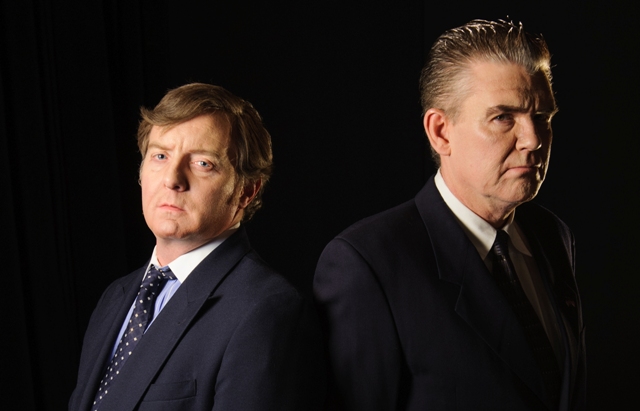FROST/NIXON at The Players Club of Swarthmore, as directed by Bridget Dougherty, is a splendid production. Peter Morgan’s 2006 play is an adaptation of the true story of a series of TV interviews that occurred in 1977 between British talk show host / aspiring journalist, David Frost, and the then-resigned ex-President, Richard Nixon.
The heart of the drama is the high stakes involved with both primary players. Frost had bankrolled much of his own money to secure the exclusive interview in the hopes of augmenting his troublesome career. Nixon, who was widely viewed in disgrace, saw the interview as an opportunity to tell his side of the story to what he assumed would be a soft-ball inquisitor. If Frost fails to get the goods on Nixon, he will be penniless and unemployable. If Nixon fails to regain his image, he has no future in Washington or any way to return to the hearts of Americans.
Having never previously seen the play or the movie adaptation of the same name, I assumed the story would involve a healthy dose of simplicated Nixon bashing. Instead, Nixon is most complex character in the play and, arguably, the most sympathetic. Half of this is due to Morgan’s excellent script. The other half, though, is the tremendous performance given by Jeff Ragan. Ragan effortlessly mimics all of Nixon’s familiar vocal inflections, gestures, and head-bobs without ever descending into clownish caricature. He is fascinating to watch onstage and on screen (more on that later) and highlights his performance with a healthy dose of humor.
Also notable is Eric Jarrell as Frost, who plays the part of a “desperate journalist who doesn’t want to come across as desperate” very well. The scenes between him and his team of researchers (Thomas Robert-Irvin, Jim Broyles, and Anthony SanFilippo) are appropriately tense, as each man has much to lose if the interviews fail, which appears to be the case for much of the play. The other ensemble roles, many playing multiple characters, also shine.
The most engaging aspect of the production is the use of live video cameras to capture the debates as they occur on stage. A large screen behind the actors show Ragan and Jarrell’s performances live and in close-up. This is not just a cool effect, it’s crucial to the story because it shows the characters how the 1977 audience would have seen them. Nixon was largely chastised after the interviews, and with the way the interviews are presented in this production, it’s easy to see why.
With this positive comes a negative, however. In order for the actors to be filmed live, the large TV cameras have to be placed in specific locations downstage, while the actors themselves are sitting upstage. This placement almost certainly will obstruct the view of the interviews for anyone in the audience sitting close to the stage and at the sides of the house. This likely is unavoidable due to the required placement of the cameras. More perplexing, though, is that one actor has been staged close to center stage with his back to the audience, completely blocking the view of Ragan during the interviews for much of the audience until the actor eventually kneels down or moves away. My fiancee and I were seated in the middle of the right section of the house about two-thirds of the way back and even we had difficulty seeing Ragan sometimes. The solution is sit near the center of the house and, if you have to sit on one of the sides, sit as far back as possible in order to ensure a good view.
I only raise this negative because Jarrell and, especially, Ragan’s performances during the interviews are so engaging, it’s a shame to miss even a second. FROST/NIXON effectively juxtaposes humanity and high-stakes. Everyone involved should be commended for a great production of an important but often forgotten blip in media history.
FROST/NIXON
by Peter Morgan
Directed by Bridget Dougherty
February 13-28, 2015
The Players Club of Swarthmore
614 Fairview Avenue
Swarthmore, PA 19081
610-328-4271
www.pcstheatre.org


